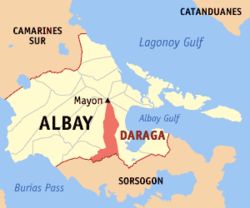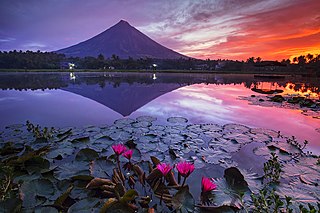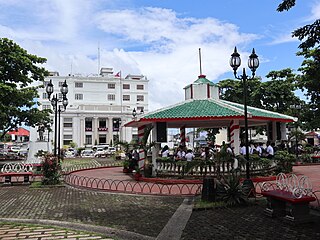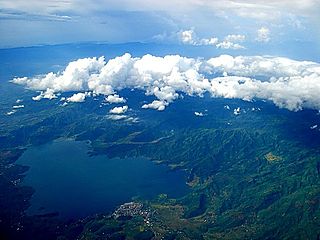This article needs additional citations for verification .(January 2013) |
Daraga Locsin | |
|---|---|
| Municipality of Daraga | |
 Daraga Church with Mayon Volcano in the background | |
| Nickname: The International Gateway to Bicol "Home of Cagsawa Ruins" | |
| Motto: Arangkada Banwa | |
 Map of Albay with Daraga highlighted | |
Location within the Philippines | |
| Coordinates: 13°09′43″N123°41′38″E / 13.1619°N 123.6939°E | |
| Country | Philippines |
| Region | Bicol Region |
| Province | Albay |
| District | 2nd district |
| Founded | June 12, 1772 |
| Barangays | 54 (see Barangays) |
| Government | |
| • Type | Sangguniang Bayan |
| • Mayor | Carlwyn G. Baldo |
| • Vice Mayor | Gerry Raphael Z. Jaucian Jr. |
| • Representative | Jose Ma. Clemente "Joey" S. Salceda |
| • Municipal Council | Members |
| • Electorate | 83,560 voters (2022) |
| Area | |
• Total | 118.64 km2 (45.81 sq mi) |
| Elevation | 79 m (259 ft) |
| Highest elevation | 292 m (958 ft) |
| Lowest elevation | 0 m (0 ft) |
| Population (2020 census) [3] | |
• Total | 133,893 |
| • Density | 1,100/km2 (2,900/sq mi) |
| • Households | 30,777 |
| Demonym | Daragueño |
| Economy | |
| • Income class | 1st municipal income class |
| • Poverty incidence | 15.47 |
| • Revenue | ₱ 382.4 million (2020), 186.6 million (2012), 205.2 million (2013), 222.4 million (2014), 257.2 million (2015), 275.9 million (2016), 312.1 million (2017), 332.7 million (2018), 357.3 million (2019), 431.1 million (2021), 559.1 million (2022) |
| • Assets | ₱ 1,514 million (2020), 405.8 million (2012), 421.6 million (2013), 440 million (2014), 477.4 million (2015), 821.8 million (2016), 1,030 million (2017), 1,260 million (2018), 1,342 million (2019), 1,705 million (2021), 2,274 million (2022) |
| • Expenditure | ₱ 363.3 million (2020), 166 million (2012), 150.4 million (2013), 159.3 million (2014), 181.9 million (2015), 191.6 million (2016), 204.2 million (2017), 239.6 million (2018), 290.1 million (2019), 334 million (2021), 462.7 million (2022) |
| • Liabilities | ₱ 521.5 million (2020), 137.4 million (2012), 134.6 million (2013), 126.9 million (2014), 183 million (2015), 229.1 million (2016), 339.7 million (2017), 473.9 million (2018), 458.5 million (2019), 558.7 million (2021), 681.9 million (2022) |
| Service provider | |
| • Electricity | Albay Power and Energy Corporation (APEC) |
| Time zone | UTC+8 (PST) |
| ZIP code | 4501 |
| PSGC | |
| IDD : area code | +63 (0)52 |
| Native languages | Tagalog |
| Website | www |
Daraga, officially the Municipality of Daraga (Central Bikol : Banwaan kan Daraga; Tagalog : Bayan ng Daraga), is a municipality in the province of Albay, Philippines. According to the 2020 census, it has a population of 133,893. [3]
Contents
- History
- Geography
- Elevation
- Soil
- Drainage
- Climate
- Barangays
- Demographics
- Language
- Economy
- Tourism
- Transportation
- Education
- Elementary
- High school
- College
- Notable people
- References
- External links
The municipality is home to the famous Cagsawa Ruins.

























